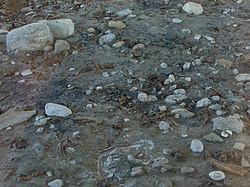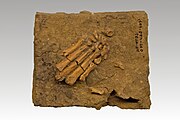Monruz outdoor station
Coordinates: 47 ° 0 '12.9 " N , 6 ° 57' 40.5" E ; CH1903: 563695 / 205947
| Monruz outdoor station | ||
|---|---|---|
|
Cast of the Magdalenian settlement horizon |
||
|
|
||
| When | 16,500–15,200 years ago | |
| Where | City of Neuchâtel , Monruz district, Switzerland | |
The Monruz open-air station was the archaeological site of a Upper Palaeolithic hunter camp , which was found in 1989 in the Neuchâtel district of Monruz. Due to the exceptionally well-preserved organic finds and the three Venus figurines from Monruz, the open-air station, with an age of 16,500–15,200 years, is one of the most important Magdalenian sites in Switzerland .
Find
When construction of the Highway 5 - the most northern shores of Lake Neuchatel to a large part due to dense development wells , enclosures and tunnels traced out is - discovered the cantonal archaeologist Michel Egloff at a construction- inspection in October 1989 a Paleolithic settlement horizon . This was in the area of the north-east running carriageway at the level of exit 14 Hauterive-St. Blaise at an altitude of 428.5 meters. M. and thus around 5 m below the water level of Lake Neuchâtel. Six years earlier, a similar complex had been discovered in Hauterive-Champréveyres, 1 km away , on which the cantonal archaeological museum Laténium is now located.
The subsequent excavations were carried out by the archaeological service of the Canton of Neuchâtel and took place in several campaigns between 1989 and 1992. Almost half of the originally 800 m² settlement area had already been destroyed and removed by civil engineering work, so that the excavations were concentrated on two 450 and 15 m² sectors. It was decided to salvage the two central settlement areas of Sector 1 with their particularly dense scattering of finds. Both blocks (block A: 18 m², 75 t; block B: 66 m², 400 t) were supported with steel pipes for transport and clad with sheet piling . In March and June 1990, respectively, they were brought to Champréveyres by heavy load for further analysis and for the production of casts.
Finding
location
The Monruz outdoor station was built in a depression in a narrow point strategically located for horse hunting between the 1180 m high Chaumont mountain and the shores of Lake Neuchâtel. It can be assumed that in addition to the proximity to the water and the sheltered location, the soft sandy silt there was also decisive for the choice of location . During the rewarming at the end of the Older Dryas Period , the water level of the lake rose rapidly, which resulted in rapid sedimentation of the abandoned settlement area and the organic materials were very well preserved by excluding the air . In addition to the Magdalenian find layer with numerous fireplaces, thousands of fauna remains and lithic artefacts, a later inspection of the camp in Azilien could be proven.
fauna
In Monruz, more than 14,000 fauna remains with a total weight of almost 100 kg were measured three-dimensionally. Half of the pieces weighing 85 kg come from juvenile and adult wild horses , which shows that the herd associations were hunted, not the bachelor communities . It is detected with a minimum of 56 complete animals and is therefore to be regarded as the main prey, followed by marmots (17 animals), mountain hare (7), ibex and ground squirrel (4 each). In addition to the reindeer and brown bear (3 each), there were also remains of bison , polecat , ice fox and domestic dog (1 each). A further 1,500 determinable and 72,000 non-determinable animal remains originate from the sludge residues .
Since wild horses keep a great distance from human settlements and can only be transported over short distances when hunted, it is assumed that the Monruz camp was established after a successful horse hunt. Above all, the numerous teeth of young animals and the presence of marmots and ground squirrels - both of which could not be hunted during hibernation - make the outdoor station likely to be used during the summer months. The camp was used for 20 re-inspections and a stay of one to three weeks can be derived from the amount of food that was available in each case. Due to the mobility of Paleolithic hunters and gatherers , a maximum of two stays per year can be assumed.
Fire pits
Based on the exposed hearth constructions made of rubble and stone slabs, as well as the associated layers of charcoal, a multitude of insights into the way of life at that time and the prevailing flora could be gained. There were 36 fireplaces of various sizes in the camp, half of which were sunk into the ground. Only thin branches of creeping willow were available as fuel , so the fires were not burned openly, but rather limited and covered with rubble and stone slabs. In this way, branches and leaves could be used much more efficiently to prepare food and to heat any existing dwellings. More than 5000 stones with a total weight of almost 2 t were analyzed, more than half of them showed traces of fire, and a large number of them had burst due to the action of heat. Fragments have often been reused several times on different hearths, so that based on compositions of a chronological sequence of fireplaces use proposed could be.
Organic devices and jewelry
In addition to numerous blanks and pieces with traces of workmanship, nine spearheads, three barbs of harpoons and a fragment of a piercer have been preserved from reindeer antlers . With a hole diameter of around 30 mm, it is comparable to the largest specimens of the settlement area on Petersfels near Engen, which was visited at the same time . Monruz is also connected to this cave, 170 km away as the crow flies , north-west of Lake Constance , through three stylized female statuettes and a gag made from Gagat . The artefacts of both sites are so similar in shape and size that there is speculation about whether the same artist designed these pieces. From the snail sands of the Steinheim Basin, 300 km away on the Swabian East Alb , 19 fossil, drilled casings of the snail species Gyraulus trochiformis steel come . They are almost undamaged and are an indication of the spaciousness of the hunting grounds of the hunter-gatherer groups of that time.
Stone tools
The lithic inventory with dimensions of over 1 cm comprises almost 45,000 pieces and has a total weight of 77 kg. This includes 203 prepared cores and around 1400 artifacts, which can be referred to as tools or inserts for projectile tips . In addition to 900 knives, there are 500 burins , drills and micro-drills . There are only a few scratches , the rest are pieces of waste. In addition, there are another 48,000 pleats and waste with a size of less than 1 cm. From the total amount, 5839 fragments could be put together to make 1,373 structures .
The local raw material deposits are of poor quality, which is why a wide variety of non-local materials were imported to Monruz, sometimes over very long distances. They were brought in at different stages of processing, e.g. B. in the form of cores or as finished tools. Silex could be found all over the area, but concentrated at around 200 points around the fire pits. The distribution patterns and the quality of the production waste show that the less experienced rock breakers were only allowed to process the inferior local flint. The catchment area for the raw material supply extended over several hundred kilometers from the Mâconnais in what is now France over the entire Jura mountains to the Swabian Alb .
See also
literature
- Marie-Isabelle Cattin, Jehanne Affolter, Sylvie Beyries: Le site magdalénien de Monruz, 4 - La vie quotidienne à travers le travail du silex . (= Archeology neuchâteloise. 51). Hauterive / Switzerland, 2012, ISBN 978-2-940347-54-4 . (French)
- Werner Müller, Denise Leesch: Le site magdalénien de Monruz, 3 - Acquisition, traitement et consommation des ressources animales . (= Archeology neuchâteloise. 49). Hauterive / Switzerland, 2013, ISBN 978-2-940347-52-0 . (French)
- Nicole Plumettaz: Le site magdalénien de Monruz, 2 - Étude des foyers à partir de l'analyse des pierres et de leurs remontages . (= Archeology neuchâteloise. 38). Hauterive / Switzerland, 2007, ISBN 978-2-940347-34-6 . (French)
- Jérôme Bullinger, Denise Leesch, Nicole Plumettaz: Le site magdalénien de Monruz, 1 - Premiers éléments pour l'analyse d'un habitat de plein air . (= Archeology neuchâteloise. 33). Hauterive / Switzerland, 2006, ISBN 2-940347-29-8 . (French)
Web links
Individual evidence
- ↑ Denise Leesch, Werner Müller: New radiocarbon dates on bones, teeth and antlers from Magdalenian sites in Switzerland and their significance for the position of the Magdalenian within the late glacial . Archéologie neuchâteloise, Hauterive 2012. pp. 297–300
- ↑ a b c d Marie-Isabelle Cattin: Le site magdalénien de Monruz, 4 - La vie quotidienne à travers le travail du silex. Archéologie neuchâteloise, Hauterive 2012. pp. 297–300
- ↑ a b c d Werner Müller, Denise Leesch: Le site magdalénien de Monruz, 3 - Acquisition, traitement et consommation des ressources animales . Archéologie neuchâteloise, Hauterive 2013. pp. 291–292
- ↑ Jérôme Bullinger, Denise Leesch, Nicole Plumettaz: Le site magdalénien de Monruz, 1 - Premiers éléments pour l'analyse d'un habitat de plein air . Archéologie neuchâteloise, Hauterive 2006. pp. 11–15 and 217–227
- ↑ Jérôme Bullinger, Denise Leesch, Nicole Plumettaz: Le site magdalénien de Monruz, 1 - Premiers éléments pour l'analyse d'un habitat de plein air . Archéologie neuchâteloise, Hauterive 2006. p. 168
- ↑ a b Nicole Plumettaz: Le site de Magdalénien Monruz, 2 - Étude the foyers à partir de l'analyze des pierres et de leurs remo day . Archéologie neuchâteloise, Hauterive 2007. p. 268
- ↑ Jérôme Bullinger, Denise Leesch, Nicole Plumettaz: Le site magdalénien de Monruz, 1 - Premiers éléments pour l'analyse d'un habitat de plein air . Archéologie neuchâteloise, Hauterive 2006. pp. 139–147, plates 27–33
- ↑ Gerd Albrecht: Reduced silhouettes: depictions of women from Petersfels. In: Ice Age: Art and Culture - Archaeological State Museum Konstanz (Ed.) . Thorbecke, Ostfildern 2009. pp. 307-311
- ↑ Jérôme Bullinger, Denise Leesch, Nicole Plumettaz: Le site magdalénien de Monruz, 1 - Premiers éléments pour l'analyse d'un habitat de plein air . Archéologie neuchâteloise, Hauterive 2006. pp. 154–165, plates 34, 35
- ^ Esteban Alvarez-Fernandez: Magdalénian personal ornaments on the move: A review of the current evidence in Central Europe . Santander 2009. p. 47






